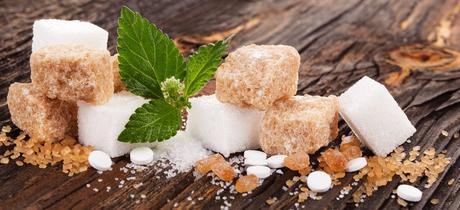
Sugar has never been considered a healthy food, but it has still become a major part of our diet. Whether sugar is simply a source of "empty calories" or something more sinister has been an ongoing debate among nutrition experts. Read on to learn all about sugar, the many ways it impacts health, and practical takeaways for decreasing your intake.
What is sugar?
When you hear the term "sugar," you probably think of white table sugar, or sucrose. In reality, there are actually a number of different types of sugar.
Chemically, sugars are either single sugar molecules (monosaccharides) or, more commonly, two sugar molecules linked together (disaccharides). These sugars occur naturally in many foods, and some types are also added to processed foods.
Monosaccharides
Glucose: Glucose is the main sugar found in blood and one of your body's major fuels. In fact, the term "blood sugar" is often used interchangeably with "blood glucose."
Food sources: fruit and fruit juice (especially bananas, oranges, grapes, and dates), beets, carrots, honey.
Fructose: Fructose is sometimes referred to as "fruit sugar" because it's found in many fruits. Unlike glucose, your body can't use fructose directly for energy.
Food sources: fruit and fruit juice (especially mangoes, cherries, pears, and watermelon), asparagus, artichokes, sugar snap peas, honey, agave nectar.
Disaccharides
Sucrose: Sucrose contains one glucose molecule and one fructose molecule linked together. As a disaccharide, it is too large for your body to absorb. In your digestive tract, sucrose is broken down into glucose and fructose, which are absorbed separately into your bloodstream.
Food sources: fruits, table sugar, molasses, coconut sugar, honey, maple syrup, and any foods or beverages that contain added sucrose.
Lactose: Lactose contains one molecule of glucose and one molecule of galactose, another monosaccharide. It is the main sugar found in dairy foods. Similarly to sucrose, lactose is broken down into its monosaccharide components so that they can be absorbed into your bloodstream.
Food sources: milk, buttermilk, yogurt, ricotta cheese, cottage cheese, sour cream, whey.
Maltose: Maltose contains two glucose molecules linked together. It results from the breakdown of starch (a long chain of glucose molecules) in your digestive tract. In addition, it's increasingly being used in place of high-fructose corn syrup in processed foods. Because your body breaks down maltose into two glucose molecules which are absorbed directly into your bloodstream, consuming starchy foods and beverages can raise blood sugar considerably even though they don't taste sweet.
Food sources: potatoes, sweet potatoes, corn, bread, pasta, beer, some breakfast cereals, processed foods.
Is "natural" sugar better?
Naturally occurring sugars are often considered healthier than plain white table sugar. However, though less processed, they still contain the same sugars and therefore have similar effects in your body.
For instance, coconut sugar is about 70-80% sucrose, with the remainder coming from glucose and fructose.
Agave nectar or syrup contains at least 60% fructose, with the remainder coming from other sugars and carbohydrates.
Honey contains nearly equal portions of glucose and fructose as its main sugars, along with smaller amounts of sucrose, maltose, and other sugars.
Sugars of all types are sometimes referred to as "simple carbohydrates" because they are small molecules that are rapidly absorbed into the bloodstream. Learn more about carbs:
Sugar's effects in your body
Sugar has been implicated in several diseases and health problems, especially when consumed in large amounts. Based on its ability to quickly raise blood sugar, glucose would seem to be the most harmful component in sugar. However, research has shown that excess fructose may actually be far worse in the long term.
Fructose is absorbed more slowly into your bloodstream than glucose. Yet, unlike glucose, it can't be used by your cells as an energy source. Instead, it is taken up by the liver, where it can be converted to glucose or glycogen, the storage form of glucose. However, at typical modern-day intakes, fructose is converted by the liver into triglycerides (fat), setting the stage for insulin resistance, weight gain, fatty liver, and other health issues.
Potential health effects of sugar overconsumption include:
- Potentially increased cardiovascular disease risk: In addition to raising triglycerides and insulin, high sugar intake may lead to decreased HDL cholesterol and smaller LDL particles - all of which may increase heart attack risk. A 2014 observational study found that people who consumed 25% or more of their calories from sugar were more than twice as likely to die from heart disease as those who consumed less than 10% of their calories from sugar.
- Controversial link to ADHD: While much discussed, the potential link between sugar and ADHD has been pretty much ruled out by the failure to confirm it in controlled interventional studies. There does not appear to be any clear link between sugar per se and ADHD, despite earlier observational findings. However, there appears to be some connection between food and ADHD, as a major study found improvements in ADHD symptoms by excluding many foods, including reducing the intake of sugar and processed foods.
What is the recommended daily intake of sugar in the US?
The 2015-2020 Dietary Guidelines for Americans recommend that added sugars be limited to less than 10% of total calories. For a person consuming 2000 calories per day, this is 50 grams or about 12 teaspoons of sugar per day.
The American Heart Association 's recommendations are somewhat stricter, with proposed limits of 25 grams (6 teaspoons) of added sugar per day for women and 38 grams (9 teaspoons) per day for men.
In 2015, The World Health Organization (WHO) recommended that added sugars be limited to less than 10% of total calorie intake, and ideally less than 5% of total calories (or about 6 teaspoons daily) for maximal health benefits.
Keep in mind that these limits are for added sugars, like white table sugar, honey, high fructose syrup, and all the processed foods and beverages to which they're added. Those figures don't include naturally occurring sugars in fruit or fruit juice. Fruit juice in particular is loaded with sugar. In fact, some researchers have called for the complete elimination of 100% fruit juice from children's diets in order to lower the alarming rates of childhood obesity.
The recommended intake of added sugars in the dietary guidelines is lower than the estimated 17 teaspoons a day consumed by the average American. However, it still seems too high given the potential health risks - especially as the guidelines don't include any limits on naturally occurring sugars at all.

Added sugar
While most people would agree that eating too much sugar isn't wise, many have no idea how much they're consuming on a regular basis. Just how much added sugar is in our food, anyway?
One study found that 74% of processed foods sold in US supermarkets between 2005 and 2009 contained added sugars. This includes condiments like barbecue sauce and ketchup, as well as "natural" snacks like granola bars and fruit smoothies.
Moreover, some of the worst offenders are non-fat and low-fat products that are marketed as healthy alternatives. When fat is removed from food, sugar is often added in order to compensate for the loss of flavor and creaminess.
Non-fat and low-fat foods high in sugar include:
- Flavored yogurt: Contains up to 28 grams (7 teaspoons) of sugar per cup
- Fat-free salad dressing: Contains up to 10 grams (2.5 teaspoons) of sugar per 2 Tablespoons
- Low-fat granola: Contains up to 28 grams (7 teaspoons) of sugar per cup
- Non-fat mocha: Contains up to 33 grams (8 teaspoons) of sugar per 16 ounces (450 ml)
Food labels don't specify how much sugar in a product is added versus occurring naturally. If sugar is among the first three ingredients listed on a label, however, it's certain to contain a significant amount of added sugar.
Also, keep in mind the many different names for sugar. Read ingredients labels with a keen eye to make sure you don't overlook any of them. Here is a cheat sheet that can help you identify sugar on any food label, along with other less-than-healthy ingredients to avoid.
Sugar and the obesity epidemic
Obesity rates have skyrocketed in recent years, and it's clear that increased sugar intake has been a contributing factor.
From an evolutionary standpoint, sugar is a very recent addition to our diet - one that our bodies aren't really designed to handle in any great amount.
When it was first produced in New Guinea back in the Middle Ages, sugar was only consumed by royalty and very wealthy individuals because it was rare and expensive. However, between the 1500s and1800s, sugar plantations were established in many countries, which significantly increased sugar's availability and reduced its cost. This led to greater sugar consumption worldwide, which increased further when the prime minister of England removed the sugar tax in 1874, making it even more affordable. In fact, the average sugar intake is estimated to have doubled in the US and the UK between 1900 and 1970.
Still, up until the past few decades, sugar wasn't a major part of most people's diets. Sweets were enjoyed occasionally, but they were generally reserved for holidays, birthdays, and other special occasions.
Today, sweet food is everywhere. From breakfast pastries to fruit smoothies, sodas, and sweetened coffee drinks, sugar is often consumed at every meal and snack.
Researchers have discussed a number of ways that excessive sugar intake promotes obesity, including a centuries-old genetic mutation that gave rise to a "thrifty gene" that makes some people more susceptible to weight gain when they consume a lot of sugar - in particular, its fructose component.
In his best-selling book " The Case Against Sugar," science journalist Gary Taubes discusses sugar's role in the diabetes and obesity epidemics. You can also watch him speak about it in this presentation, The problem with sugar.
4,752 views
The sugar industry
The sugar industry is a multibillion-dollar business with a vested interest in making sure people around the world continue to consume sugar on a regular basis.
Over the past 15 years, the amount of money US politicians have received from sugar lobbyists has steadily increased, reaching a peak of $8 million USD in 2016.
Moreover, a group of researchers recently published disturbing information about the sugar industry dating back several decades.
After conducting an extensive review of documents from the Sugar Research Foundation, these researchers learned that in the 1960s and 1970s, the foundation paid scientists to publish a review that downplayed sugar's connection to heart disease and focused on dietary fat as a culprit instead. Additionally, they found that the organization suppressed animal research suggesting that high sugar intake may increase the risk of bladder cancer.
For additional information, read this article.

